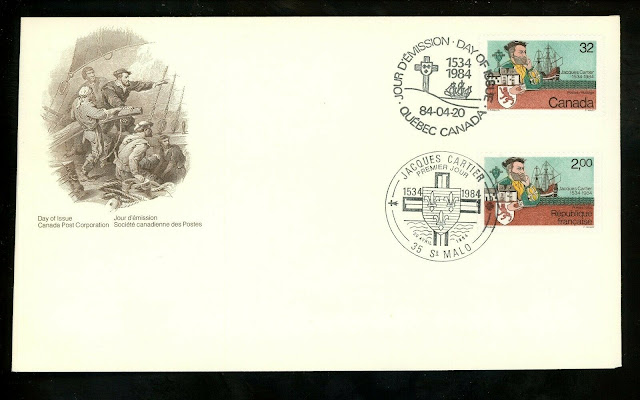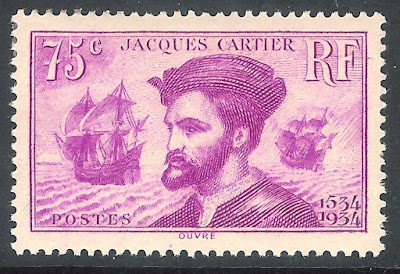Some stamps and a First Day Cover from France and Canada depicting Jacques Cartier
1754 Born: Louis XVI of France (d. 1793)
Louis XVI (Louis-Auguste; 23 August 1754 – 21 January 1793) was the last king of France before the fall of the monarchy during the French Revolution. He was referred to as Citizen Louis Capet during the four months just before he was executed by guillotine. In 1765, upon the death of his father, Louis, Dauphin of France, he became the new Dauphin. Upon his grandfather Louis XV's death on 10 May 1774, he assumed the title King of France and Navarre, until 4 September 1791, when he received the title of King of the French until the monarchy was abolished on 21 September 1792.
The first part of his reign was marked by attempts to reform the French government in accordance with Enlightenment ideas. These included efforts to abolish serfdom, remove the taille (land tax) and the corvée (labour tax), and increase tolerance toward non-Catholics as well as abolish the death penalty for deserters. The French nobility reacted to the proposed reforms with hostility, and successfully opposed their implementation. Louis implemented deregulation of the grain market, advocated by his economic liberal minister Turgot, but it resulted in an increase in bread prices. In periods of bad harvests, it led to food scarcity which, during a particularly bad harvest in 1775, prompted the masses to revolt. From 1776, Louis XVI actively supported the North American colonists, who were seeking their independence from Great Britain, which was realised in the 1783 Treaty of Paris. The ensuing debt and financial crisis contributed to the unpopularity of the Ancien Régime. This led to the convening of the Estates-General of 1789. Discontent among the members of France's middle and lower classes resulted in strengthened opposition to the French aristocracy and to the absolute monarchy, of which Louis and his wife, Queen Marie Antoinette, were viewed as representatives. Increasing tensions and violence were marked by events such as the storming of the Bastille, during which riots in Paris forced Louis to definitively recognize the legislative authority of the National Assembly.
Louis's indecisiveness and conservatism led some elements of the people of France to view him as a symbol of the perceived tyranny of the Ancien Régime, and his popularity deteriorated progressively. His unsuccessful flight to Varennes in June 1791, four months before the constitutional monarchy was declared, seemed to justify the rumors that the king tied his hopes of political salvation to the prospects of foreign intervention. The credibility of the king was deeply undermined, and the abolition of the monarchy and the establishment of a republic became an ever-increasing possibility. The growth of anti-clericalism among revolutionaries resulted in the abolition of the dîme (religious land tax) and several government policies aimed at the dechristianization of France.
In a context of civil and international war, Louis XVI was suspended and arrested at the time of the Insurrection of 10 August 1792. One month later, the absolute monarchy was abolished and the First French Republic was proclaimed on 21 September 1792. Louis was then tried by the National Convention (self-instituted as a tribunal for the occasion), found guilty of high treason, and executed by guillotine on 21 January 1793, as a desacralized French citizen under the name of Citizen Louis Capet, in reference to Hugh Capet, the founder of the Capetian dynasty – which the revolutionaries interpreted as Louis's surname. Louis XVI was the only king of France ever to be executed, and his death brought an end to more than a thousand years of continuous French monarchy. Both of his sons died in childhood, before the Bourbon Restoration; his only child to reach adulthood, Marie Therese, was given over to the Austrians in exchange for French prisoners of war, eventually dying childless in 1851.
US Stamp depicting Franklin and Louis XV
Cuvier's work is considered the foundation of vertebrate paleontology, and he expanded Linnaean taxonomy by grouping classes into phyla and incorporating both fossils and living species into the classification. Cuvier is also known for establishing extinction as a fact—at the time, extinction was considered by many of Cuvier's contemporaries to be merely controversial speculation. In his Essay on the Theory of the Earth (1813) Cuvier proposed that now-extinct species had been wiped out by periodic catastrophic flooding events. In this way, Cuvier became the most influential proponent of catastrophism in geology in the early 19th century. His study of the strata of the Paris basin with Alexandre Brongniart established the basic principles of biostratigraphy.
Among his other accomplishments, Cuvier established that elephant-like bones found in the USA belonged to an extinct animal he later would name as a mastodon, and that a large skeleton dug up in Paraguay was of Megatherium, a giant, prehistoric ground sloth. He named the pterosaur Pterodactylus, described (but did not discover or name) the aquatic reptile Mosasaurus, and was one of the first people to suggest the earth had been dominated by reptiles, rather than mammals, in prehistoric times.
His most famous work is Le Règne Animal (1817; English: The Animal Kingdom). In 1819, he was created a peer for life in honor of his scientific contributions. Thereafter, he was known as Baron Cuvier. He died in Paris during an epidemic of cholera. Some of Cuvier's most influential followers were Louis Agassiz on the continent and in the United States, and Richard Owen in Britain. His name is one of the 72 names inscribed on the Eiffel Tower.
French stamp and FDC depicting Georges Cuvier
1927 Died: Dick Bruna, Dutch author and illustrator (d. 2017)












No comments:
Post a Comment